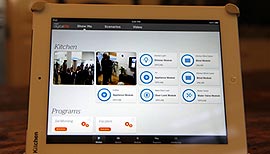
AT&T has spent a lot of
time, money and effort convincing people to use it as the service that keeps them connected within their homes. Now the company wants to protect their home as well.
In a growing trend of
telecommunications companies offering home security and automation services, AT&T on Monday announced plans to roll out a new home monitoring system called AT&T Digital Life. The service,
which won’t be tied strictly to customers using AT&T telecom products, will give consumers the ability to monitor and control home security from any Web-enabled device, including tablets,
PCs and smartphones.
The portfolio of services to be offered through the Digital Life service include monitoring of Internet-connected devices such as cameras, window and door sensors,
carbon monoxide and smoke detectors, thermostats, door locks and appliance power controls. Digital Life is scheduled to begin trials in Atlanta and Dallas this summer before rolling out
nationwide.
advertisement
advertisement
AT&T is just the latest among Internet and television service providers to begin offering home security and monitoring systems. Comcast has begun rolling out its Xfinity
Home product (which began as a test in Houston two years ago) to several new markets (including Chicago and Michigan) recently, with an expectation that it will reach the company’s entire
footprint by the end of the year. Verizon currently offers a Home Monitoring and Control service in 12 states, and Time Warner Cable has an IntelligentHome product in several of its markets as
well.
“[The cable companies] have been focused on selling triple-play packages, and they’ve found the more products they can sell to a subscriber, the less likely he is to drop
cable,” Steve Donohue, editor at cable industry news site FierceCable, tells Marketing Daily, of the strategy. “The more products they can add to the bundle, it helps with
retention.”
In response to an e-mail inquiry, an AT&T representative said the company’s decision to enter into the sector was based on “a number of factors”
including advancements in technology, increasing smartphone and tablet adoption and consumers’ willingness to use those devices in new ways to help them manage their lives.
“The industry is utilizing old technology that is not meeting customer demands,” she wrote, noting that only 20% of U.S. households have monitored home security and only 1% has home
automation. “Bottom line, it is a natural extension for us, and there is a sizable opportunity for us both to satisfy existing demand and to grow the overall scope for home security and
automation.”